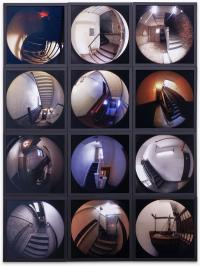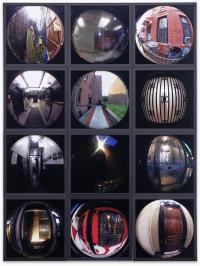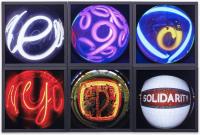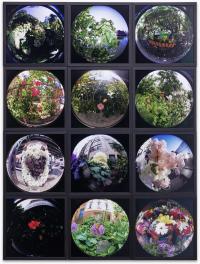Works






Installation Views
Press Release
Jan Kaps is pleased to present Emanuel Rossetti’s third solo show with the gallery.
Actualities
The exhibition consists of fish-eye photographs taken throughout the year of 2019 in New York City. The works presented are framed colour prints, organized into typological grids and further divided into four series: Signs, Halls, Gardens, Streets.
The use of the fish-eye format accentuates the perception of a gradual close-up movement by offering the sensation of glancing through an eyehole. However, another particularity of Rossetti’s photographs is the depiction of a wide one-hundred-and-eighty degree angle, representing everything that was in front of the camera during the time a picture was taken. There is no image framing in the photographic sense, even the black inner borders of the camera lens itself are represented, and the “portrait” or “landscape” formats are made irrelevant. One therefore progresses through this exhibition by being pushed from the universal to the specific and then pulled from the detailed to the general again.
If all the pictures were taken in New York, the city is not necessarily recognizable. This recalls Eugène Atget’s documentation of the city of Paris: Atget did not, in more than thirty years of work, ever photograph the Eiffel Tower, the Arc de Triomphe or Garnier’s opera. In Rossetti’s typologies we are given to see corridors, pathways, doors, staircases, streets, flowers and green sceneries. The iconic landmarks or discernible signs of New York are all missing. Additionally, while most photographic series are done under rather rigorous lighting protocols, Rossetti decided not to limit the lighting of his pictures. Throughout history, many photographers have exclusively used the most neutral daylight, others have explored only specific hours of a day, focusing on a consistent position of the source of lighting. Rossetti’s method is in opposition to such restraints.
The grid arrangements presented in the exhibition could resemble scientific classifications in adhesion to the logic of Dr. Lotfi A. Zadeh’s 1965 “fuzzy sets” - a theory which introduced the idea of categories with unsharp and ambiguous boundaries, providing a new qualitative approach to the analysis of complex systems. The real world was recognized as vague and assigning rigid values to variables meant that nuances were unfailingly lost. However, by parroting a pyramid-like representation of a well-known metropole and its spaces already devoid of situations a year before the world was forced into confinement, Rossetti also introduces the possibility of an intimate and labyrinthine depiction of the city. In reality, all the spaces in this series allow movements - from one room to another, from inside to outside, from upstairs to downstairs. The relationships between the images presented here are of “Affinity” and the idea of bringing about certain encounters and avoiding others.



















